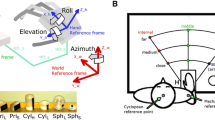Abstract
The trajectory of the index finger during grasping movements was compared to the trajectories predicted by three optimization-based models. The three models consisted of minimizing the integral of the weighted squared joint derivatives along the path (inertia-like cost), minimizing torque change, and minimizing angular jerk. Of the three models, it was observed that the path of the fingertip and the joint trajectories, were best described by the minimum angular jerk model. This model, which does not take into account the dynamics of the finger, performed equally well when the inertia of the finger was altered by adding a 20 g weight to the medial phalange. Thus, for the finger, it appears that trajectories are planned based primarily on kinematic considerations at a joint level.







Similar content being viewed by others
References
Berkinblit M, Gelfand I, Feldman A (1986) Model of the control of the movements of a multijoint limb. Biophysics 31:142–153
Biess A, Nagurka M, Flash T (2006) Simulating discrete and rhythmic multi-joint human arm movements by optimization of nonlinear performance indices. Biol Cybern 95:31–53
Biess A, Liebermann D, Flash T (2007) A computational model for redundant human three-dimensional pointing movements: integration of independent spatial and temporal motor plans simplifies movement dynamics. J Neurosci 27:13045–13064
Cruz E, Kamper D (2006) Kinematics of point-to-point finger movements. Exp Brain Res 174:29–34
Dejmal I, Zacksenhouse M (2006) Coordinative structure of manipulative hand-movements facilitates their recognition. IEEE Trans Biomed Eng 53:2455–2463
Dempster W (1955) Space requirements of the seated operator. Technical Report WADC-TR-55-159, Aerospace Medical Research Laboratories, Wright-Patterson Air Force Base, OH
Flanagan J, Ostry D (1989) Trajectories of human multi-joint arm movements: evidence of joint level planning. In: Hayward V, Khatib O (eds) Experimental robotics I. Lecture Notes in Control and Information Sciences. Springer, Germany, pp 594–613
Flash T (1987) The control of hand equilibrium trajectories in multi-joint arm movements. Biol Cybern 57:257–274
Flash T, Hogan N (1985) The coordination of arm movements: an experimentally confirmed mathematical model. J Neurosci 5:1688–1703
Friedman J (2007) Features of human grasping. PhD thesis, Weizmann Institute of Science, Israel
Friedman J, Flash T (2007) Task-dependent selection of grasp kinematics and stiffness in human object manipulation. Cortex 43:444–460
Gupta A, Rash GS, Somia NN, Wachowiak MP, Jones J, Desoky A (1998) The motion path of the digits. J Hand Surg 23A:1038–1042
Hahn P, Krimmer H, Hradetzky A, Lanz U (1995) Quantitative analysis of the linkage between the interphalangeal joints of the index finger. J Hand Surg 20B:696–699
Hermens F, Gielen S (2004) Posture-based or trajectory-based movement planning: a comparison of direct and indirect pointing movements. Exp Brain Res 159:340–348
Jeannerod M (1981) Intersegmental coordination during reaching at natural visual objects. In: Long J, Baddeley A (eds) Attention and performance IX, Lawrence Erlbaum Associates, Philadelphia, pp 153–169
Kamper D, Cruz E, Siegel M (2003) Stereotypical fingertip trajectories during grasp. J Neurophysiol 90:3702–3710
Laczko J, Jaric S, Tihanyi J, Zatsiorsky V, Latash M (2000) Components of the end-effector jerk during voluntary arm movements. J Appl Biomech 16:14–25
Littler JW (1973) On the adaptability of man’s hand (with reference to the equiangular curve). Hand 5:187–191
Mason C, Gomez J, Ebner T (2001) Hand synergies during reach-to-grasp. J Neurophysiol 86:2896–2910
Murray R, Li Z, Sastry S (1994) A mathematical introduction to robotic manipulation. CRC Press, Boca Raton
Nakano E, Imamizu H, Osu R, Uno Y, Gomi H, Yoshioka T, Kawato M (1999) Quantitative examinations of internal representations for arm trajectory planning: minimum commanded torque change model. J Neurophysiol 81:2140–2155
Norkin CC, Levangie PK (1992) Joint structure and function. A comprehensive analysis, 2nd edn. F.A. Davis Company, Philadelphia
Okadome T, Honda M (1999) Kinematic construction of the trajectory of sequential arm movements. Biol Cybern 80:157–169
Rosenbaum D, Meulenbroek R, Vaughan J, Jansen C (2001) Posture-based motion planning: applications to grasping. Psychol Rev 108:709–734
Santello M, Flanders M, Soechting J (2002) Patterns of hand motion during grasping and the influence of sensory guidance. J Neurosci 22:1426–1435
Scheidt RA, Ghez C (2007) Separate adaptive mechanisms for controlling trajectory and final position in reaching. J Neurophysiol 98:3600–3613
Secco E, Visiolo A, Magenes G (2004) Minimum jerk motion planning for a prosthetic finger. J Robotic Syst 21:361–368
Smeets J, Brenner E (1999) A new view on grasping. Motor Control 3:237–271
Soechting J, Lacquaniti F (1981) Invariant characteristics of a pointing movement in man. J Neurosci 1:710–720
Soechting J, Buneo C, Herrmann U, Flanders M (1995) Moving effortlessly in three dimensions: does Donder’s law apply to arm movement? J Neurosci 15:6271–6290
Uno Y, Kawato M, Suzuki R (1989) Formation and control of optimal trajectory in human multijoint arm movement. Biol Cybern 61:89–101
Wada Y, Kaneko Y, Nakano E, Osu R, Kawato M (2001) Quantitative examinations for multi joint arm trajectory planning—using a robust calculation algorithm of the minimum commanded torque change trajectory. Neural Netw 14:381–393
Acknowledgments
This research was supported in part by the German–Israeli Project Cooperation (DIP) and by the Moross Laboratory at the Weizmann Institute of Science. Tamar Flash is an incumbent of the Dr. Hymie Morros Professorial chair. We thank Armin Biess for his assistance in generating the predicted trajectories.
Author information
Authors and Affiliations
Corresponding author
Appendix: dynamic equations
Appendix: dynamic equations
Complete details of the derivation can be found in Friedman (2007). The 3 × 3 inertia matrix for a 3 joint finger is given by
where l are the lengths of the phalanges, lc are the lengths to the center of the phalanges, c i is the cosine of joint angle i, c ij is the cosine of angle i + j, s i is the sine of joint angle i, and m are the masses of the phalanges.
The other three terms of the inertia matrix can be found from the symmetry property of the inertia matrix.
The Coriolis and centrifugal forces are given by
Rights and permissions
About this article
Cite this article
Friedman, J., Flash, T. Trajectory of the index finger during grasping. Exp Brain Res 196, 497–509 (2009). https://doi.org/10.1007/s00221-009-1878-2
Received:
Accepted:
Published:
Issue Date:
DOI: https://doi.org/10.1007/s00221-009-1878-2




